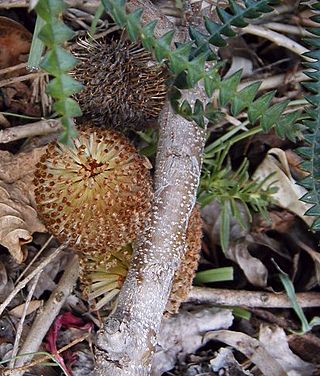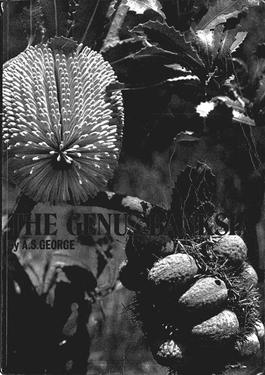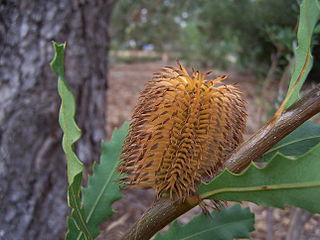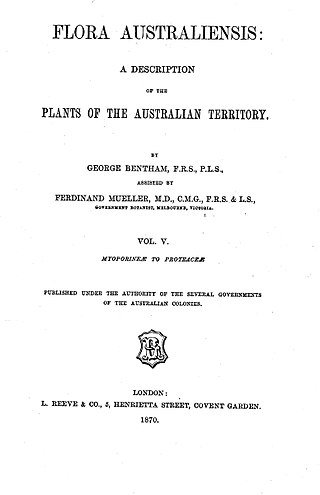Related Research Articles

Banksia subg. Banksia is a valid botanic name for a subgenus of Banksia. As an autonym, it necessarily contains the type species of Banksia, B. serrata. Within this constraint, however, there have been various circumscriptions.

As with other flowering plants, the taxonomy of Banksia has traditionally been based on anatomical and morphological properties of the Banksia flower, fruiting structure and seed, along with secondary characteristics such as leaf structure and growth habit. Increasingly, molecular evidence from DNA is providing important new insights into relationships within the genus and between this and other genera in the Proteaceae.

Banksia lindleyana, commonly known as the porcupine banksia, is a species of woody shrub in the genus Banksia of the family Proteaceae. It generally grows as a small shrub to 1 m (3 ft) high with long narrow serrated leaves, and bright yellow oval or round inflorescences. Flowering occurs in late summer, after which time the flower spikes age and turn to brown and then grey, and develop up to 70 follicles. It occurs in the vicinity of Kalbarri, Western Australia. Found on sandy soils, the plant serves as a pollinator for a variety of bird and animal species.

Banksia ser. Dryandroideae is a taxonomic series in the plant genus Banksia. First published by Carl Meissner in 1856, the name has had two circumscriptions. As presently circumscribed it is monotypic, containing only B. dryandroides.

Banksia ser. Abietinae is a valid botanic name for a series of Banksia. First published by Carl Meissner in 1856, the name has had three circumscriptions.

Banksia ser. Salicinae is a valid botanic name for a series of Banksia. First published by Carl Meissner in 1856, the name has had three circumscriptions.

The taxonomy of Banksia integrifolia has a long and complex history, the result of confusion caused by the species' great variability, and similarities with some closely related species. The existence of hybrids between B. integrifolia and related species as well as early attempts to classify the species based on dried specimen material have also contributed to the confusion.

"The genus Banksia L.f. (Proteaceae)" is a 1981 monograph by Alex George on the taxonomy of the plant genus Banksia. Published by the Western Australian Herbarium as Nuytsia3(3), it presented George's taxonomic arrangement of Banksia, the first major taxonomic revision of the genus since George Bentham published his arrangement in Flora Australiensis in 1870.

Banksia ser. Quercinae is a valid botanic name for a series of Banksia. First published by Carl Meissner in 1856, the name has had three circumscriptions.

Banksia ser. Cyrtostylis is a taxonomic series within the plant genus Banksia. First published at sectional rank by George Bentham in 1870, it was demoted to a series by Alex George in 1981. The name has had three circumscriptions.

Banksia ser. Banksia is a valid botanic name for a series of Banksia. As an autonym, it necessarily contains the type species of Banksia, B. serrata. Within this constraint, however, there have been various circumscriptions.
This is a timeline of developments in knowledge and understanding of the Australian plant genus Banksia:

George Bentham's taxonomic arrangement of Banksia was published in 1870, in Volume 5 of Bentham's Flora Australiensis. A substantial improvement on the previous arrangement, it would stand for over a century. It was eventually replaced by Alex George's 1981 arrangement, published in his classic monograph The genus Banksia L.f. (Proteaceae).
Kevin Thiele and Pauline Ladiges taxonomic arrangement of Banksia, published in 1996, was a novel taxonomic arrangement that was intended to align the taxonomy of Banksia more closely with the phylogeny that they had inferred from their cladistic analysis of the genus. It replaced Alex George's 1981 arrangement, but most aspects were not accepted by George, and it was soon replaced by a 1999 revision of George's arrangement. However some herbaria have continued to follow Thiele and Ladiges on some points.
Robert Brown's taxonomic arrangement of Banksia was published in his book of 1810, Prodromus Florae Novae Hollandiae et Insulae Van Diemen, and expanded in the supplement to that publication, Supplementum Primum Prodromi Florae Novae Hollandiae, in 1830. It was the first survey of Banksia species to be published, and included descriptions of a number of previously undescribed species.

Alex George's taxonomic arrangement of Banksia was the first modern-day arrangement for that genus. First published in 1981 in the classic monograph The genus Banksia L.f. (Proteaceae), it superseded the arrangement of George Bentham, which had stood for over a hundred years. It was overturned in 1996 by Kevin Thiele and Pauline Ladiges, but restored by George in 1999. A recent publication by Austin Mast and Kevin Thiele suggests that it will soon be overturned again.

Banksia sect. Eubanksia is an obsolete section of Banksia. There have been two circumscriptions, one of which is synonymous with the recently abandoned B. subg. Banksiasensu Alex George, the other having no modern equivalent.

Banksia spinulosa var. collina is a shrub that grows along the east coast of Australia, in Queensland and New South Wales. Commonly known as Hill Banksia or Golden Candlesticks, it is a taxonomic variety of B. spinulosa. It is a popular garden plant widely sold in nurseries.

Banksia spinulosa var. spinulosa is a shrub that grows along the east coast of Australia, in Queensland and New South Wales.

Banksia subser. Sphaerocarpae is a valid botanic name for a subseries of Banksia. It was published by Kevin Thiele in 1996, but discarded by Alex George in 1999.
References
- 1 2 Meissner, Carl (1856). "Proteaceae". In de Candolle, A. P. (ed.). Prodromus systematis naturalis regni vegetabilis . Vol. 14. Paris: Sumptibus Sociorum Treuttel et Wurtz.
- 1 2 George, Alex S. (1981). "The Genus Banksia L.f. (Proteaceae)". Nuytsia . 3 (3): 239–473.